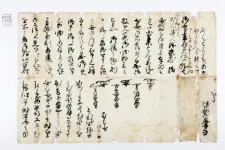In the mid-16th century, the number of Christian believers in Japan exploded with the arrival of the Jesuit missionary Francis Xavier. Eventually, some of the feudal lords, daimyos, and their vassals came to believe in Christianity. There were many Christians in the Kyushu region in particular which served as a gateway to missionary work and "southern barbarian culture." The Hosokawa family, which eventually became the lords of the Kyushu region, had many Christian retainers. It is well known that Tama (Gracia/Garasha) Hosokawa, the wife of Tadaoki Hosokawa, the second head of the family, was a Christian. She maintained her faith and met her end in a major civil war, Battle of Sekigahara, in 1600.
When the Edo shogunate issued a nationwide ban on Christianity in December 1614, Hosokawa family retainers abandoned their faith one after another. However, some vassals in the family chose not to apostatize, most notably Hayato Kagayama and Genya Ogasawara.
Hayato Kagayama was a military commander who served three feudal lords who were all closely associated with Christianity. The first two were Christian, and after losing them to banishment deportation and death from illness, he proved himself to be a highly valuable retainer to the Hosokawa family. Although Tadaoki Hosokawa himself was not Christian, his wife Gracia was a devoted Catholic.
Genya Ogasawara was Hayato's son-in-law and the son of a man famous for having been with Gracia during the last moments of her life. As the Hosokawa family residence was besieged by the enemy during the Battle of Sekigahara, Genya's father took Gracia's life and then committed seppuku, a form of ritual suicide in the samurai code of honor. Both of these acts were by order of Lord Hosokawa, who then became deeply grateful to Genya's father for protecting his wife's honor and not giving her to the enemy. Both Genya and Hayato refused to obey the order to change their religion, but it is thought that Tadaoki respected the two so much that he was unable to take decisive action to punish them.
According to Jesuit missionary reports to Rome, on September 8th, 1619, Tadaoki finally ordered the beheading of Kagayama Hayato because he refused to apostatize. He also banished Genya Ogasawara and his family from Kokura, where the Hosokawa family castle was located, to the countryside to live with unknown farmers and outlaws.
Researchers from Kumamoto University's Eisei Bunko Research Center* discovered a letter related to these orders while analyzing an archive of the Hosokawa family's first retainer, the "Matsui Family Documents." The sender, Rokuzaemon Yano, and three others were officials in charge of Genya Ogasawara's custody, and the recipient, Okinaga Matsui, was the first retainer of the Hosokawa family and the chief administrator in the Kokura domain.
[Original text] (Note: Uses some old-style Japanese kanji.)
猶々与三郎殿忝通、我々三人ゟ能々可申上由被申候、其御心得可被成候、以上、
御奉書拝見仕候、然者、加々山隼人儀、夜前 御成敗被仰付候由、奉得其意候、小笠原与三郎殿儀者、少斎御忠節ニ付被成御赦免候通、御状参之上を以 御諚之趣則申渡候、忝段可申上様も無御座由被申上候、殊子共衆迄も被成御免段申渡候、一段忝由被申上御状之御返事被仕候、自然分別相違之儀共御座候而走なと被仕候ハヽ、近所之惣庄屋・頭百姓内々心懸押置、即刻注進可仕通、堅申付候、若押申儀不罷成候ハヽ、打果シ候ても不苦由、奉得其意候、相替儀御座候ハヽ追々御注進可申上候、恐惶謹言、
申ノ下刻 矢野六左衛門
(元和五年)九月九日 政(花押) 吉田甚兵衛
(花押)
冨嶋猪兵衛
貞(花押)
長岡式阝少輔(松井興長)殿
貴報
[Translation reordered for presentation.]
We have received Lord Tadaoki's decrees.
1. The Death Penalty (Martyrdom) for Hayato Kagayama: We understand that the order to execute Hayato Kagayama was given last night (September 8).
2. Spare the Genya Ogasawara Family: We immediately informed Genya Ogasawara that our Lord decided to save his life in gratitude for Genya's father's fealty. In response, Genya said, "I am so grateful to my Lord that I am at a loss for words." When we informed him of the Lord's intention to spare the lives of his family, including his children, he expressed his heartfelt gratitude and wrote a letter of reply to our Lord. In addition, Genya said to us, "Please, the three of you, express very carefully my gratitude to Lord Tadaoki." Please keep this in mind.
3. Management of Genya Ogasawara's family: We ordered local village officials to keep a close watch on Genya, and to seize him and inform us immediately if he tries to escape from the confinement area. If it is difficult to seize him, we understand it is not a problem to execute him. If any abnormalities occur we shall report them as soon as they occur.
5:00 PM on the 9th of September,
From: Rokuzaemon Yano, Jinbei Yoshida and Ihei Tomishima,
To: First Retainer Okinaga Matsui
Professor Tsuguyo Inaba said following about this historical document: "Until now, we could only learn about the martyrdom of Hayato Kagayama and the punishment of Genya Ogasawara from the reports of Jesuit missionaries from Rome, and we could not eliminate information uncertainty. However, with the discovery of primary historical documents created by the organization that handed down the punishment, the Hosokawa family, more facts are now known. The punishment of the two men is now thought to have been carried out in the immediate aftermath of the "Great Martyrdom of Genna in Kyoto" (1619), one of the greatest incidents in the history of Japanese suppression of Christianity, by Tadaoki, who felt threatened by it. This was a shocking and decisive suppression of Christian retainers and vassals among leading feudal lords. After that point, daimyo and samurai within the family were forbidden from being Christian. This primary historical document demonstrates removal of Christians from the ruling class structure, and is a great historical discovery for Japanese Christianity."
Items 1 and 3 of this letter are almost identical to the reports sent to Rome, but item 2 has never been seen before in any historical document. Genya Ogasawara's father protected the honor of his lord's wife, Gracia, by not letting her be taken hostage during the Battle of Sekigahara. After her death, he died a martyr close by. This document clearly shows that Lord Hosokawa highly valued Genya's father's loyalty. However, the Genya Ogasawara and his family were ostracized by Hosokawa because they would not renounce their faith. Eventually they would all be executed in Kumamoto in December 1635.
The report from Jesuit missionaries at the time of Genya Ogasawara's punishment reads as follows: He was banished to the countryside where there were unknown farmers and outlaws in the territory. They were mixed in with the lower class of artisans and poor peasants and treated as if they were the lowest class of slaves or discriminated people.
However, the letter found in the Matsui Family Documents reveals that the Genya family was managed by three officials (the senders of the letter) and village officials of the region where they were confined, in other words, within the formal domain administration structure of the Hosokawa family. It is also a valuable primary historical document that concretely shows reports to Rome by Jesuit missionaries in Japan during the period of suppression can contain both facts and exaggerations.
INFORMATION:
*Eisei Bunko Research Center
"Eisei Bunko" is the name of a foundation established to retain and care for ancestral works of art, literary manuscripts, and other historical materials (ancient texts, records, illustrations, etc.) of the Hosokawa family, who were once the daimyo of Kumamoto. In 1964, several pieces from the Hosokawa Kitaoka Mansion collection in Kumamoto City were entrusted to the Kumamoto University Library. These continue to be used in educational research conducted by the University.





